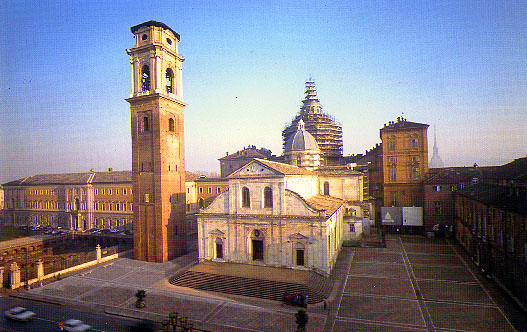![]()

![]()

Turin Cathedral
In 1988, the Church finally agreed to the carbon-14 test of the Turin Shroud. Tiny samples of the cloth were taken and forwarded to laboratories in America, England and Switzerland. With the Shroud samples went fragments of other ancient fabrics whose ages were already known to act as controls. By the autumn all tests were completed, and on 14 October the results were announced simultaneously in Turin and London. The flax from which the linen of the Shroud had been woven had been harvested some time between 1260 and 1390. Around the world the Turin Shroud was denounced by the media as a 'forgery'. Then it was discovered that, far from it being a blind testing, the scientists doing the tests had recognised the sample which had come from the Shroud, and that unauthorised persons had been allowed to witness the tests. The situation soon arose that the only people satisfied with the test were the scientists that did them, especially when it became known that all the radio-carbon dates issued by the British Museum between 1980 and 1984 had been incorrect.
Few of those who have examined the shroud believe that it is a medieval fake; they believe it is much more likely to be the burial cloth of a crucified first-century Palestinian. But who the man was can only be surmised.
If the Turin Shroud is authentic, then one mystery still remains. Where was the Shroud before 1357, when the de Charny family began to show it to fee-paying pilgrims in the French town of Lirey? Sceptics say that this was because it had only just been faked and use as the argument for their case the fact that the image of the face on the shroud conforms closely to the 14th century conventional image of Jesus - bearded, commanding, with a V-shape at the bridge of the nose. This, they say, is what a painter of that time would have painted. However, the opposite argument could be true, that the long line of traditional portrayals of Christ stems from the image on the Turin Shroud itself.
According to an ancient legend, one of the disciples healed the leprosy of King Agbar of Edessa in southern Turkey by letting him touch Christ's burial cloth, and the cloth remained in the possession of Agbar, who was the first pagan ruler to be converted to Christianity. When his successor reverted to paganism, the Christians of Edessa hid it in a niche in the city wall to protect it, where it was discovered nearly five centuries later. It is not legend but a historical fact that the Byzantines so prized a holy relic, which they called the Mandylion, (a name derived from a Greek word for an ecclesiastical robe) that they organized an expedition in 944 to wrest it from the Muslims who had gained control of Edessa. From then until the sack of Constantinople in 1204, the Mandylion was carefully guarded; it was on show to the public only twice a year. After 1204 it disappeared and was never seen again.
But what was this precious object? Apparently it was some sort of image of Christ's face imprinted on a piece of cloth, and there can be no doubt about its influence on religious art after its discovery in the city wall of Edessa. Before the early sixth century, Jesus was often pictured as short-haired and clean shaven. Thereafter he is always shown as longhaired, bearded, and with a pronounced V above the bridge of his nose - all features that correspond to the image on the Turin Shroud. Could it not be that the Mandylion lost in 1204 resurfaced as the shroud 150 years later?
One problem is that the Mandylion is reputed to have borne only the face of Christ, not his entire body. But the shroud shows signs of having been folded, and it could be that only the head was open to view. The Byzantines kept the Mandylion in a frame; they may not have been aware of its full significance. In any event, there is a good possibility that it was rescued from the sack of Constantinople and taken to France by members of the Knights Templar. It is just the sort of thing they would have done, given the opportunity. The Knights Templar made many enemies within the Christian world. One of these was France's King Philip IV, who, determined to suppress the Templars, had many of their leaders burned at the stake in 1313. One man among Philip's victims was named Geoffrey de Charney - a variant spelling for de Charny. Could Geoffrey's family have been the very people who put the Mandylion on display in 1357 as the burial shroud of Christ? At least, it is a plausible explanation of the sudden appearance of this relic after a lapse of many centuries.
This, then, is a brief history of the object known as the Turin Shroud, with one or two of the arguments for and against its authenticity thrown in. Whether or not you think this is indeed the burial shroud of Jesus Christ is up to you. You have to make your own mind up about it. But whether you are for or against, you must admit it is an interesting bit of history.
written by Bill Hutchings
![]() Return to the Summer 1999 Features page
Return to the Summer 1999 Features page
![]() return to Home page and main index
return to Home page and main index
page last updated 1 JULY 1999